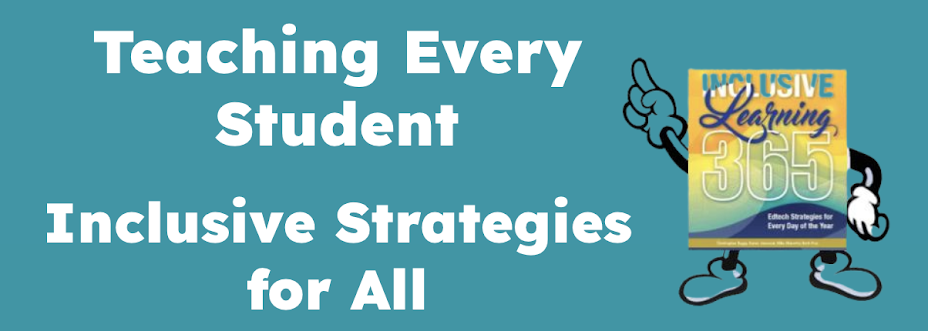I've heard that refrain numerous times.
"But... he doesn't want to be seen as different."
It's usually uttered in response to specific technology recommendations offered during the IEP team process. The team typically nods their head in agreement; after all, it is a priority that the student completes school tasks in the same manner as their peers, or uses the same school tools as their friends.(Or is it?)
Unfortunately, I realize another team is unaware of Universal Design for Learning principles. If they understood UDL, they would appreciate the importance of offering MULTIPLE methods of engagement, presentation and expression. Instead, they are sticking to the "one size fits all" approach, an approach which fails to meet the needs of all learners. It's an approach that allows teams to agree, "He doesn't want to be seen as different."
My challenge to the team is to change the culture, don't let the student be seen as different. Offer multiple methods of expression. Give choices. Offer alternatives to the traditional methods which fail many kids.
Sometimes students need a different method.
A classic example is the Poster Board.
Think of all the poster boards that have been assigned over the years. For some students, the fine motor or visual processing skills required to complete that task are nearly impossible without significant help from home. Paper can be the disability. Two alternatives are Glogster or VoiceThread, free online multimedia tools which minimize the potential output challenges. In addition, these tools can be more engaging.
But don't just change the expectation to ALL students will now create a Glog. Introduce them to the tools. Then let students choose the tool which will help them accomplish the task in the way that works best for them. Promote an environment where they are not seen as different. Every one chooses the method which promotes success. Some students will opt for the paper poster board, others will choose another option.
The essential point is the availability of choice. When there is choice, no one is seen as different. Every student gets what they need.
Easily accomplished in an age of numerous tool choices. Need a starting place? Refer to the UDL Tech Toolkit wiki to get you going.

4 comments:
Thank you for this excellent post, Karen. You point out such an important point about the need to shift our thinking. It's true, when we bring in an accomodation, we typically do tend to impose change on all the students...but more appropriate would be introducing multiple strategies for students to choose from.
I'd wager to guess that part of the argument in the back of teachers' minds is how they can assess a variety of projects. A good way around this problem is to have in place a SOLID rubric for evaluating the output. Having the criteria clear in mind...and clearly communicated from the start...voids that argument and benefits the whole class.
Thanks for this!
I just heard this on Thursday as I was interviewing a new teacher. She apologized that she had not learned more about how to "differentiate" when at college. Then she said, well, I did learn some, but everything is changing so quickly. I think more teachers, preservice, new and veteran need to be given permission to do things differently with assignments and offer more choices with each assignment.
Great blog post.
I would hope that we can agree that as an educator our job is to prepare our students for the future, whatever path they choose to pursue. In doing so, we have to understand that our students will have to be able to be creative in their own way and be able to problem solve. We can do this in the classroom by, yes providing an excellent rubric and allowing multiple resources. Many teachers see differentiation as more work for them; so what!? Remember our overall goal is get them prepared at all costs. Not every task is performed the same way day in and day out in the work field. Technology is a great tool we can use to allow students to explore and be creative in their demonstration(s) to us letting us know if they have mastered the content.
I think you're right on when you say "Offer multiple methods of expression. Give choices. Offer alternatives to the traditional methods which fail many kids". I feel that this is the key not only to learning, but to motivation for learning with many students.
Allowing choice is HUGE in how we create classroom communities and learning environments. Using different modes of expression applies to the UDL principle that many teachers are striving for during the 21st Century.
Taking into account the assistive and instructional technology that is available, and even thinking about alternatives that may be "low tech", can create opportunities for a multitude of students to learn the same curriculum. And this can be done within ONE classroom; maybe even an inclusion classroom.
Post a Comment